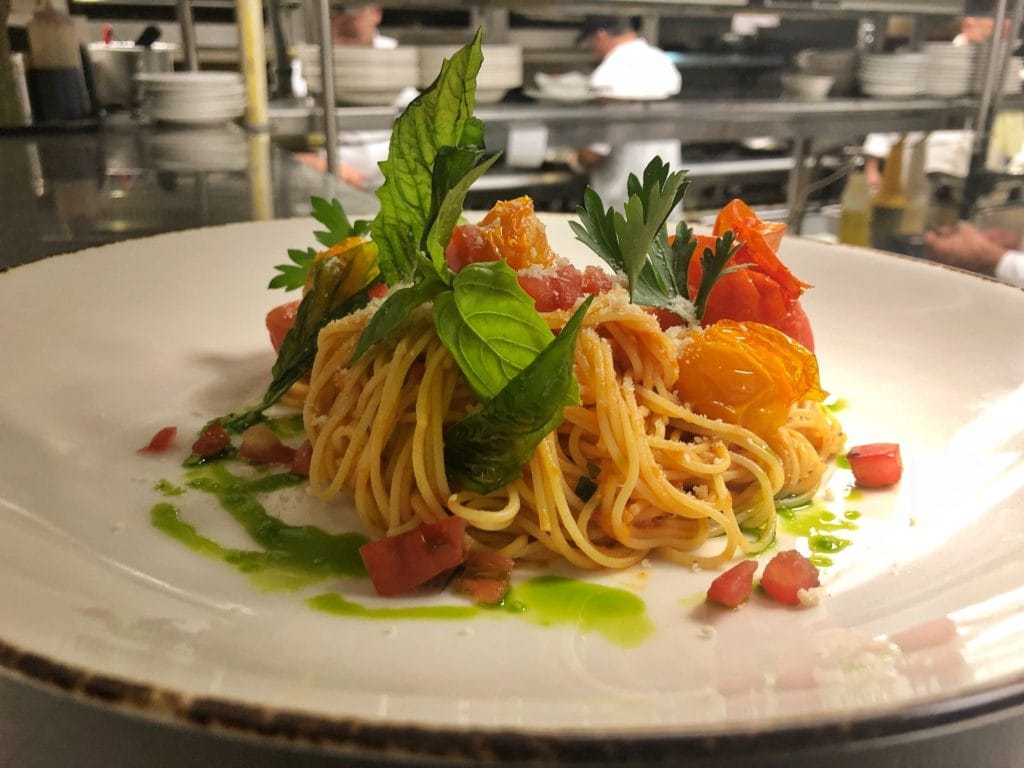Arrabiata and Pomodoro sauces are both popular in Italian cuisine, each known for their delicious flavors and versatility. These tomato-based sauces have their distinct characteristics, making them shine in various Italian dishes. Although they may appear similar at first glance, these sauces cater to different taste preferences and culinary applications.
Arrabiata Sauce vs Pomodoro:

Arrabiata sauce, famous for its spicy kick, can be found predominantly in Central Italy, around Rome. This sauce is known to include red chili peppers, garlic, and olive oil, giving it a fiery taste that can enhance any pasta dish. On the other hand, Pomodoro sauce is recognized for its light and fresh flavor, commonly used across the entirety of Italy. Instead of spicy elements, the Pomodoro sauce focuses on the rich taste of tomatoes, often combined with garlic and olive oil.
Key Takeaways
- Arrabiata sauce is known for its spicy flavor, while Pomodoro sauce has a lighter, fresh taste.
- Both sauces have a tomato base, but their additional ingredients create distinct taste profiles.
- Arrabiata sauce is more popular in Rome and Central Italy, while Pomodoro sauce is widely used throughout the country.
What is Arrabiata Sauce?
Arrabbiata sauce, also known as sugo all’arrabbiata, is a traditional Italian sauce boasting a perfect balance of flavor and spiciness. It primarily consists of San Marzano tomato paste, garlic, and dried red chili peppers, all of which are cooked in extra virgin olive oil to achieve a rich, delicious taste1.
The name “arrabbiata” translates to “angry” in English, and this moniker signifies the fiery kick that the sauce delivers, courtesy of the red chili peppers in its recipe. This distinct and bold flavor profile sets arrabbiata sauce apart from many other pasta sauces, making it a popular choice for those seeking a more adventurous culinary experience.
Arrabbiata sauce is often paired with pasta dishes, notably penne all’arrabbiata – a classic Italian combination. Other uses can include serving as a dipping sauce for appetizers such as calamari or a topping for pizza and bruschetta. Its zesty and versatile nature allows it to elevate a wide range of dishes.
In crafting this spicy concoction, the quality of the ingredients is crucial. Authentic arrabbiata sauce requires San Marzano tomatoes2, a type of tomato recognized for its unique sweetness and low acidity. These tomatoes, coupled with the aromatic garlic and fiery chili peppers, make for an irresistible sauce, adding heat and depth to any meal.
In summary, arrabbiata sauce is a fiery, bold, and flavorful Italian sauce, known for its distinct spiciness derived from red chili peppers. It pairs well with pasta dishes and can enhance various other recipes with its robust flavors.
Footnotes
- (https://www.truff.com/articles/arrabiata-sauce) ↩
- (https://www.crustkingdom.com/difference-between-pomodoro-marinara-and-arrabbiata/) ↩
What is Pomodoro Sauce?

Pomodoro sauce is a classic Italian tomato sauce that originates from southern Italy. It is known for its simplicity and fresh flavor. The sauce is a staple in many Italian dishes and is often used as a base for pasta and pizza.
The main ingredients in pomodoro sauce are tomatoes, basil, olive oil, garlic, and salt. Fresh, ripe tomatoes make up the majority of the sauce, giving it a bright, rich flavor. Basil adds a touch of earthy sweetness that complements the tomatoes, while olive oil brings a silky texture to the mix. The addition of garlic provides a subtle, savory undertone, and salt is used to enhance the overall taste of the sauce.
Pomodoro sauce can be prepared in various ways; some prefer to use fresh tomatoes and cook them down, while others opt for canned tomatoes for a quicker option. In a traditional preparation, tomatoes are blanched, peeled, and crushed before being combined with the other ingredients. The sauce is then simmered for a short period, allowing the flavors to meld together while still maintaining the freshness and vibrancy of the tomatoes.
Compared to other tomato-based sauces such as marinara and arrabbiata, pomodoro sauce has a lighter, fresher taste, making it an excellent choice for dishes that require a less robust sauce. For instance, it pairs well with delicate pasta shapes and can also be used as a simple topping for bruschetta. The versatility and simplicity of pomodoro sauce make it a popular choice in Italian cuisine and beyond.
Ingredients Comparison
Primary Ingredients
Arrabbiata and Pomodoro are both tomato-based sauces, but they have some differences in their primary ingredients. For Arrabbiata sauce, the main ingredients are tomatoes, garlic, and crushed red pepper flakes, which give the sauce its characteristic spicy kick source. The spiciness of the sauce varies, but it is generally considered to be quite hot and not just mildly spicy source.
On the other hand, Pomodoro sauce primarily consists of tomatoes, garlic, and olive oil. The sauce is known for its light and fresh flavor profile source. San Marzano tomatoes are often used in both sauces for their sweet taste and low acidity source.
Additional Ingredients
In addition to their primary ingredients, both Arrabbiata and Pomodoro sauces may include various herbs and other elements to enhance their flavor profiles. Arrabbiata sauce might incorporate ingredients such as onion, basil, or even butter, depending on the recipe source. On the other hand, Pomodoro sauce recipes often include onion and fresh basil to add an aromatic touch source.
While both sauces share some similarities in their ingredients, it is the presence of crushed red pepper in Arrabbiata and the lighter flavors in Pomodoro that distinguish the two sauce types. In conclusion, the ingredients used in both Arrabbiata and Pomodoro sauces contribute to their unique flavors and textures. These differences make each sauce a perfect fit for various pasta dishes and preferences.
Taste and Texture Contrast
Arrabbiata sauce and pomodoro sauce are both derived from tomatoes, yet they present unique flavors and textures in their own right.
Arrabbiata sauce is known for its spicy kick, resulting from the addition of red pepper flakes or fresh chili peppers. This heat is typically balanced by the sweetness of tomatoes and the aromatic flavors of garlic and onion. The sauce has a fairly smooth texture, as its ingredients are usually finely chopped or blended together. This consistency allows arrabbiata to cling well to pasta, accentuating the spiciness throughout the dish (source).
On the other hand, pomodoro sauce showcases a light and fresh taste that highlights the natural flavor of tomatoes. The key ingredients in pomodoro sauce are usually limited to tomatoes, garlic, olive oil, and fresh basil, creating a simpler flavor profile (source). The texture of pomodoro sauce is typically chunkier than arrabbiata due to the presence of diced tomatoes. The denser consistency may also be attributed to the shorter cooking time, which results in a sauce that maintains its bright and fresh characteristics.
In summary, the taste and texture of arrabbiata and pomodoro sauces represent contrasting culinary experiences. For those seeking a bold, spicy flavor, arrabbiata sauce is an excellent choice. Conversely, those looking to enjoy a dish with a light and refreshing tomato essence may prefer pomodoro sauce.
Health Benefits and Nutrition
Arrabbiata sauce and Pomodoro sauce are both tomato-based sauces originating from Italian cuisine. Both sauces boast nutritional benefits, primarily due to their tomato content. Tomatoes are rich in vitamins and minerals, such as vitamin C, potassium, and antioxidants, specifically lycopene1. These nutrients contribute to various health benefits when consumed as part of a balanced diet.
Arrabbiata Sauce: Arrabbiata sauce is made from tomatoes, garlic, olive oil, and red pepper flakes2. This spicy sauce gets its heat from the addition of red pepper flakes, which give it a unique flavor. The capsaicin found in these peppers is believed to have health benefits, like improved metabolism and potential pain relief3. Additionally, the garlic in Arrabbiata sauce has numerous health benefits, including antibacterial properties and possible heart health improvements4.
Pomodoro Sauce: Pomodoro sauce is a simple, yet flavorful sauce, comprised of tomatoes, garlic, olive oil, and fresh basil5. Basil not only adds a distinct flavor to the sauce but also has antioxidant and anti-inflammatory properties6. While Pomodoro sauce may not have the heat of Arrabbiata sauce, it still offers a delicious and nutritious tomato-based option.
In summary, both Arrabbiata and Pomodoro sauces offer health benefits due to their tomato content and additional ingredients. Arrabbiata sauce provides the added benefits of capsaicin from red pepper flakes, while Pomodoro sauce features the flavorful and healthful properties of basil.
Footnotes
- https://www.healthline.com/nutrition/foods/tomatoes ↩
- https://flamesurfers.com/pomodoro-vs-marinara-vs-arrabbiata/ ↩
- https://www.medicalnewstoday.com/articles/265922 ↩
- https://www.healthline.com/nutrition/11-proven-health-benefits-of-garlic ↩
- https://www.crustkingdom.com/difference-between-pomodoro-marinara-and-arrabbiata/ ↩
- https://www.healthline.com/nutrition/whats-the-difference-between-continual-and-continuous-epochs ↩
Uses in Italian Cuisine
Arrabbiata sauce and Pomodoro sauce are both popular in various Italian dishes, but their unique flavors and ingredients offer different culinary experiences.
Arrabbiata sauce is famous for its spicy kick, which comes from the addition of red chili peppers. This spicy tomato sauce is mainly used in central Italy, specifically around Rome, where it is believed to have originated. Arrabbiata sauce is commonly paired with penne pasta, creating the popular dish called Penne all’Arrabbiata. However, it can also be used in other pasta dishes, as well as a topping for bruschetta, bread, and pizza.
Key ingredients of Arrabbiata sauce include crushed tomatoes, red chili peppers, garlic, and olive oil. Some variations also add onion, parsley, or basil for additional flavor. The heat of the chili peppers nicely balances the sweetness of the tomatoes, giving the sauce its distinctive bold taste.
Pomodoro sauce, on the other hand, has a milder flavor and is considered a more traditional Italian tomato sauce. The term Pomodoro means “tomato” in Italian, and this sauce is widely used across the whole country. Pomodoro sauce typically contains crushed tomatoes, garlic, olive oil, and fresh basil leaves. Its simple and fresh ingredients make Pomodoro sauce an ideal choice for many pasta dishes, such as Spaghetti al Pomodoro, as well as a staple for pizza toppings.
The difference between Pomodoro and Arrabbiata sauce lies in their flavor profiles and regional preferences. While Pomodoro sauce has a gentler, more classic tomato taste, Arrabbiata sauce adds a spicy twist to traditional Italian tomato sauce recipes. Ultimately, the choice between these two sauces depends on personal preferences and the desired heat level for a
